Trees in Containers III
This is a continuation of the second thread on the same topic, both having topped out at 150 posts. You can find a link to the previous thread and the helpful information/conversations it contains at the bottom of this post.
Trees in Containerscolor>size>
A discussion about maintaining trees in containers over the long termsize>color>
It's not much of a secret to many, that a good part of what I've learned about plants and plant-related science has come as an outgrowth of my pursuit of at least some degree of proficiency at bonsai. Please, make no mistake, the principles applied to containerized trees under bonsai culture can, and in most cases SHOULD be applied to all containerized trees grown for the long term. Because of the small volumes of soil and small containers these trees are grown in, you might look at bonsai as a form of container culture taken to another level. Before most of the plants I grow become bonsai, they often undergo many years of preparation and manipulation while still in the same size containers you are growing in, so while I am intimately familiar with growing plants in bonsai culture, it would have been impossible for me to arrive at that familiarity w/o an even more thorough understanding of growing woody plants in larger, pre-bonsai size containers like you grow in. This thread is a continuation of one I previously posted on the same topic.
I grow and manage a wide variety of temperate trees and shrubs, both deciduous and conifers, and 75 or more tropical/subtropical woody plants. I'd like to invite you to join the discussion with questions about your own containerized trees and/or your tree problems. I will try to answer your questions whenever I can.
The timing of certain procedures is closely related to energy management, which gets too little consideration by most growers tending trees in containers. Because repotting and root pruning seem to be most misunderstood on the list of what it takes to maintain trees that will continually grow at close to their genetic potential, I will include some observations about those procedures to open the discussion.
I have spent literally thousands of hours digging around in root-balls of trees (let's allow that trees means any woody plant material with tree-like roots) - tropical/subtropical trees, temperate trees collected from the wild and temperate nursery stock. The wild collected trees are a challenge, usually for their lack of roots close to the trunk, and have stories of their own. The nursery stock is probably the closest examples to what most of your trees are like below the soil line, so I'll offer my thoughts for you to consider or discard as you find fitting.
I've purchased many trees from nurseries that have been containerized for long periods. Our bonsai club, just this summer, invited a visiting artist to conduct a workshop on mugo pines. The nursery (a huge operation) where we have our meetings happened to have purchased several thousand of the mugos somewhere around 10 - 12 years ago and they had been potted-up into continually larger containers ever since. Why relate these uninteresting snippets? In the cases of material that has been progressively potted-up only, large perennial roots occupied nearly the entire volume of the container, plant vitality was in severe decline, and soil in the original root-ball had become so hard that in some cases a chisel was required to remove it.
In plants that are potted-up, rootage becomes entangled. As root diameters increase, portions of roots constrict flow of water and nutrients through other roots, much the same as in the case of girdling or encircling roots on trees grown in-ground. The ratio of fine, feeder roots to more lignified and perennial roots becomes skewed to favor the larger, and practically speaking, useless roots.
Initial symptoms of poor root conditions are progressive diminishing of branch extension and reduced vitality. As rootage becomes continually compressed and restricted, branch extension stops and individual branches might die as water/nutrient translocation is further compromised. Foliage quality may not (important to understand) indicate the tree is struggling until the condition is severe, but if you observe your trees carefully, you will find them increasingly unable to cope with stressful conditions - too much/little water, heat, sun, etc. Trees that are operating under conditions of stress that has progressed to strain, will usually be diagnosed in the end as suffering from attack by insects or other bio-agents while the underlying cause goes unnoticed.
I want to mention that I draw distinct delineation between simply potting up and repotting. Potting up temporarily offers room for fine rootage to grow and do the necessary work of water/nutrient uptake, but these new roots soon lignify, while rootage in the old root mass continues to grow and become increasingly restrictive. The larger and larger containers required for potting-up & the difficulty in handling them also makes us increasingly reluctant to undertake even potting-up, let alone undertake the task of repotting/root-pruning which grows increasingly difficult with each up-potting.
So we are clear on terminology, potting up simply involves moving the plant with its root mass and soil intact, or nearly so, to a larger container and filling in around the root/soil mass with additional soil. Repotting, on the other hand, includes the removal of all or part of the soil and the pruning of roots, with an eye to removing the largest roots, as well as those that would be considered defective. Examples are roots that are dead, those growing back toward the center of the root mass, encircling, girdling or j-hooked roots, and otherwise damaged roots.
I often explain the effects of repotting vs potting up like this:
Let's rate growth/vitality potential on a scale of 1-10, with 10 being the best. We're going to say that trees in containers can only achieve a growth/vitality rating of 9, due to the somewhat limiting effects of container culture. Lets also imagine that for every year a tree goes w/o repotting or potting up, its measure of growth/vitality slips by 1 number, That is to say you pot a tree and the first year it grows at a level of 9, the next year, an 8, the next year a 7. Lets also imagine we're going to go 3 years between repotting or potting up.
Here's what happens to the tree you repot/root prune:
year 1: 9
year 2: 8
year 3: 7
repot
year 1: 9
year 2: 8
year 3: 7
repot
year 1: 9
year 2: 8
year 3: 7
You can see that a full repotting and root pruning returns the plant to its full potential within the limits of other cultural influences for as long as you care to repot/root prune.
Looking now at how woody plants respond to only potting up:
year 1: 9
year 2: 8
year 3: 7
pot up
year 1: 8
year 2: 7
year 3: 6
pot up
year 1: 7
year 2: 6
year 3: 5
pot up
year 1: 6
year 2: 5
year 3: 4
pot up
year 1: 5
year 2: 4
year 3: 3
pot up
year 1: 4
year 2: 3
year 3: 2
pot up
year 1: 3
year 2: 2
year 3: 1
This is a fairly accurate illustration of the influence tight roots have on a woody plant's growth/vitality. You might think of it for a moment in the context of the longevity of bonsai trees vs the life expectancy of most trees grown as houseplants, the difference between 4 years and 400 years, lying primarily in how the roots are treated.
I haven't yet mentioned that the dissimilar characteristics of the old soil as compared to the new soil when potting-up are also a recipe for trouble. With a compacted soil in the old roots and a fresh batch of soil surrounding the roots of a freshly potted-up tree, it is nearly impossible to establish a watering regimen that doesn't keep the differing soils either too wet or too dry, both conditions occurring concurrently being the rule rather than the exception.
Most who read this would have great difficulty showing me a containerized tree that's more than 10 years old and as vigorous as it could be, unless it has been root-pruned at repotting time; yet I can show you hundreds of trees 20 years to 200 years old and older that are in perfect health. All have been root-pruned and given a fresh footing in in new soil at regular and frequent intervals.
Deciduous trees are some of the most forgiving of trees when it comes to root pruning. The process is quite simple and the long term benefits include best opportunities for plants to grow at or near their potential genetic vigor, and stronger plants that are able to resist the day to day perils that bring down weaker plants. Root-pruning is a procedure that might be considered borrowed from bonsai culture, but as noted above, bonsai culture is nothing more than highly refined container culture, and to restrict the practice of root-pruning to bonsai only, is an injustice to those of us who simply enjoy growing trees in containers.
Trees are much like human beings and enjoy each other's company. Only a few love to be alone. ~Jens Jensen
Now that I have made the case for why it is important to regularly perform full repots (not to be confused with potting-up) and prune the roots of your containerized trees regularly, I will offer some direction. Root-pruning is the systematic removal of the largest roots in the container with emphasis on removal of rootage growing directly under the trunk and at the perimeter of the root mass.
Root pruning can start immediately with year-old seedlings by removing the taproot just below the basal flare of dormant material, repotting, and treating the plant as a cutting. This will produce a plant with flat rootage that radiates outward from the base and that will be easy to care for in the future.
Young trees (under 10 yrs old) are nearly all dynamic mass and will tolerate root-pruning well. Most deciduous trees are extremely tolerant of root work. Acer buergerianum (trident maple) is routinely reduced to a main trunk with roots pruned all the way back to the basal flare and responds to the treatment with a fresh growth of fine, fibrous roots and a fresh flush of foliage each spring. The point here is, you don't need to be concerned about the pruning if you follow a few simple guidelines.
First, some generalities: undertake repotting of most deciduous material while the plant is quiescent (this is the period after the tree has met its chill requirement and has been released from dormancy, but has not begun to grow yet because of low soil temps). Most conifers are best repotted soon after the onset of spring growth. Most tropical and subtropical trees are best repotted in the month prior to their most robust growth period (summer). Citrus are probably best repotted in spring, but they can also be repotted successfully immediately after a push of top growth.
For most plants that have not been root-pruned before: With a pruning saw, saw off the bottom 1/3 of the root ball. With a hand-rake (like you use for scratching in the garden soil) and/or a wooden chopstick and/or the aid of water under high pressure from a garden hose, remove all the loose soil. Using a jet of water from the hose and the chopstick, remove the remaining soil - ALL of it. The exception here would be those plants that form dense mats of fine roots (citrus, bougainvillea, rhododendron ...). This should be done out of sun and wind to prevent the fine roots from drying. 5 minutes in the sun or wind can kill fine roots & set the tree back a week or more, so keep roots moist by misting very frequently or dipping the roots in a tub of water as you work. After the soil is removed, remove up to another 1/3 of the remaining mass of roots with a sharp pruning tool, taking the largest roots, and those roots growing directly under the trunk. Stop your pruning cuts just beyond where a smaller root branches toward the outside of the root you are pruning. Be sure to remove any J-hooked roots, encircling/girdling roots or others exhibiting abnormal growth.
Before you begin the pruning operation, be sure you have the soil & new container ready to go (drain screens in place, etc). The tree should fit loosely inside the walls of the container. Fill the container with soil to the desired ht, mounded in the center, & place tree on the mound. Add soil to cover roots & with a chopstick/skewer, or sharpened wood dowel, work soil into all voids in the roots, eliminating the air pockets and adding soil to the bottom of the basal root-flare. Temporarily securing the tree to the container with twine or small rope, even staking, against movement from wind or being jostled will fractionalize recovery time by helping to prevent breakage of newly-formed fine rootage. Place the tree in shade & out of wind until it leafs out and re-establishes in the container.
The first time you root-prune a tree will be the most difficult & will likely take up to an hour from start to finish, unless the tree is in larger than a 5 gallon container. When you're satisfied with the work, repot into a soil that you are certain will retain its structure until the next root-pruning/repot. Tree (genetic) vigor will dictate the length of time between repots. The slow growing, less vigorous species, and older trees will likely go 5 years between repots. For these slow growing trees, it is extremely important that soils retain aeration. For these trees, a soil of 2/3 inorganic parts and 1/3 organic (I prefer pine or fir bark) is a good choice. The more vigorous plants that will only go 2 years between repots can be planted in a soil with a higher organic component if you wish, but would still benefit from the 2/3 inorganic mix.
Most trees treated this way will fully recover within about 4 weeks after the repot By the end of 8 weeks, they will normally have caught & passed, in both development and in vitality, a similar root-bound plant that was only potted up
When root-pruning a quiescent plant, you needn't worry much about "balancing" top growth with rootage removed. The plant will tend to only "activate" the buds it can supply with water. It is, however, the optimum time to undertake any pruning you may wish to attend to.
This is how I treat most of my trees. Though I have many growing in bonsai pots, more of my plants are in nursery containers or terra-cotta and look very much like your trees, as they await the beginning of intensive training. With a little effort at developing a soil from what's available to you and some knowledge and application of root-pruning and repotting techniques, I'm absolutely sure that a good % of those nurturing trees in containers could look forward to results they can be very pleased with. This is the repotting technique described that allows bonsai trees to live for hundreds of years & be passed from generation to generation while other containerized trees that have not had their roots tended to, and have only been potted-up, are likely to be in severe decline, or compost, well before they're old enough to vote. ;o)
I hope you're bold enough to make it a part of your containerized tree maintenance, and I hope what I've written so far makes sense. Thank you so much for your interest.
Al
Knowing grass, I understand the meaning of persistence.
Knowing trees, I understand the meaning of perseverance.
Knowing bonsai I understand the meaning of patience. ~ Al
If interested, follow the embedded link to the previous discussion about trees in containers.
Comments (236)
thepleiades (Z8b-9A: San Antonio, TX)
7 years agoHi Al,
Thank you so much for your thoughts. I agree, the dominant branches are currently on the sides and it doesn't give it a cohesive look. The interior branches aren't as strong and established as the ones on the sides, but I can see which one I would like to be the apex.
As for the crossing branches, you're right; they don't look like welcoming arms, but more like the "A" in the YMCA dance, hah. I thought it was a weird but interesting feature when I first got this tree from a relative last year. I don't really mind the crossing trunks, but I would like to encourage the smaller offshoots from the two trunks to branch out.
So when I'm making the cuts, I'll have to significantly cut down the two side branches to allow the branch that I think I want as the apex to grow. I'm willing to make drastic cuts so it will improve its look over the next year. However, I was worried that making too many cuts (where the majority of the mature leaves are) would make the tree's photosynthesis process more difficult. Is that a legitimate concern or am I just overthinking it?
Also, I'd welcome any advice on how to trim the lower portion of the tree to encourage branching. I should be trying to get the bottom branches to grow upwards, right? Would it be helpful if I take a picture and indicate where I want the new leader to be to get more specific cutting advice?
Thanks again!Holden Beck
7 years agoThose trees can take a lot of cutting. You could probably cut it to a stump and it would grow. So don't let that discourage any cutting.
If you want bushy, you need to cut the vertical branching more to encourage lateral growth. See pic for suggestion.
When I lived in Nicaragua people would trim these trees in squares/ rectangles on the side walk. They can really fill out and look nice given the right conditions.

Related Professionals
Cedar Hill Landscape Contractors · Shoreview Landscape Contractors · West Chester Landscape Contractors · Camp Springs Landscape Contractors · San Pablo Landscape Contractors · Lynwood Solar Energy Systems · Muscatine Solar Energy Systems · Nutley Solar Energy Systems · Wixom Window Contractors · Roselle Park Window Contractors · Cockeysville Fence Contractors · Goose Creek Fence Contractors · Madison Fence Contractors · Richmond Fence Contractors · Winnetka Fence Contractorsthepleiades (Z8b-9A: San Antonio, TX)
7 years agoThanks for your suggestions on cutting, Holden. I'll get on the trimming later today!
tapla (mid-Michigan, USDA z5b-6a)
Original Author7 years agoTP -
* Select the branch you want to be the leader and leave it for now.
* I want to use a branch as an example of what to do next: Look at Holden's image, and particularly at the lower right branch. I'm singling out this branch because it's easy to identify. You won't cut this branch back, but you'll cut the vertically growing branches except the leader back in this fashion - in June.
* Start at the tip of that low right branch and follow the central leader back to the last (closest to the trunk) two live branches and truncate it there. IOW, if you were cutting that branch back, you would cut it back to those 2 living branches. Then, you would look at those living branches and follow those back to the last (closest to the trunk) 2 living branches. If there was a third order of branches, you would do it again until everything except the leader was cut back to 2 living branches.
* Ok, that's HOW you prune it, but you don't prune the branches on the lower 1/3 of the tree. The plant is apically dominant and will devote 2/3 of it's energy into the top 1/3 of the tree, so to keep that energy balanced, you need to keep the top of the tree in hard check so the bottom can thrive.
* So, in June, prune like I said. Then tip-prune all branches with 3 or more leaves back to 2 leaves. When that's done, the leader will be sticking up well above the other foliage, Prune that back to a branch slightly higher than the rest that's pointing in the direction you want the leader to grow. It will back-bud like mad if the tree is healthy.
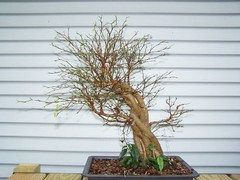
* Then, wait until next summer to prune again.
Al
thepleiades (Z8b-9A: San Antonio, TX)
7 years agoAl, thank you for the amazingly clear advice! I'm saving this. Unfortunately I got a little excited and started some minor pruning before I saw your post (oops!) - but I'll wait to do the significant pruning work until June. The tree is back in its favorite spot outside and I'm hoping it'll put on some good growth through the summer.
tapla (mid-Michigan, USDA z5b-6a) thanked thepleiades (Z8b-9A: San Antonio, TX)Naak Goods
6 years agoHi Everyone :)
I need some Advice on my Yucca. So glad I found this thread!
My Yuccu has been in the same spot in my apartment thriving for the past 3 years (it grew like crazy) and then it suddenly started going downhill. I realised/suspect my mistake was that i did not repot it in time and when I finally did it was hectically root-bound (the roots were as hard as stone and growing in a dense spiral) I loosened and untangled the roots as much as I could (before doing proper research and finding this thread in the process ) and repotted into a bigger pot with fresh soil. Since then it has started making new growth but very slowly the bottom leaves are limping and are dying off. Should i repot again but this time actually cut 1/3 of the roots off and then prune off the other roots as AL has described above? Or Does it have a disease? (dark brown/rust colour at base of leaves) Also- there are these weird dust spots on some leaves. I am certain it gets enough light and the watering routine is also good.
Our spring is in at the end of August -should I prune it then or try save it now?
I think I also need to aerate the soil more - can big pine chips also work or must I use Pine bark Fines?
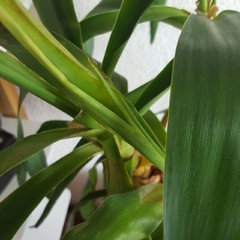
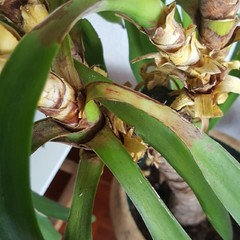

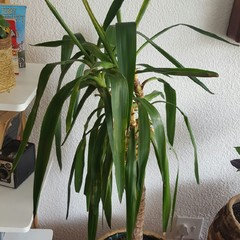

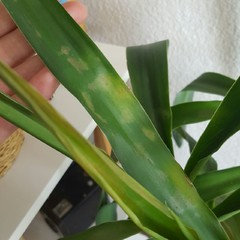

Ocho (z9 - Istanbul)
6 years agoIve been lurking/reading/absorbing as much as I can from these threads for awhile, but I havent seen anything that clearly solves my dilemma yet, so here goes.
I want to separate a pair of sapling pines (probably stone pine, since that's the most common thing propagated in these parts) currently inhabiting the same pot on my balcony. I received them as tiny seedlings in plugs of dense claylike soil. I planted them in what was then this really oversized pot, with regular potting mix without removing any of the clay (you can see the clay on the second and third pics below). They are around 5 years old now.
I would like to get them into a situation where they are able to thrive, each with a pot of its own. In some sort of gritty mix that I have yet to find all the parts for (Good luck me). I will do it this spring, but Im not sure how to proceed. Most of the advice I have seen here advocates only bare-rooting deciduous trees.
Should I first separate them by sawing between them and then, without disturbing their roots further (like, not cutting off the bottom 1/3 since this will already be a harsh procedure), potting them up separately? After that, I can let them recover for a year and replace all of the old soil bit by bit over the next few years. My concern there is that then we will have three completely different soils involved for awhile.
Another option might be to forego the sawing and try to sort them out more carefully to avoid damaging the roots, while replacing most of the soil in a single go. I can try to comb out most of the roots and replace most of the soil, since the trees are still pretty young. Im not sure how rootbound or entangled they are, but very few if any roots are reaching through the bottom of the pot. This seems more risky to me.
I feel like this is a pretty tough first project for a newbie, but I dont have much time for practice runs. They will only get more tangled if I leave them go and I dont want to lose them, as they have sentimental value. Any advice will be much appreciated.
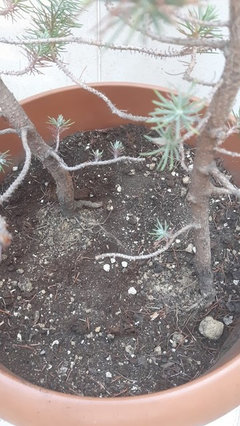

mblan13
6 years agoI'd hack right down the middle with a hack saw or bread knife and pot them, like you stated, for a year or two., Roots are tougher than you thing and pines are fairly resilient.
Take that with a grain of salt though, I tend to be a bit of a ham fisted goon!
halocline
6 years agozm - Hi there,
I wouldn't start by sawing in half. See if you can remove the entire soil mass (root ball) from the pot. Begin by removing the old soil with a root rake/hook (or similar tool), and assess what is going on with the separate tree roots, it might not be as difficult as you think, they may not be tangled at all.
I would remove most of the old soil 80%-85% regardless of what the provided link (below) says. The site doesn't explain why they don't recommend bare rooting, but I suspect it's to maintain the existing Mycorrhizae in the old soil, to populate the new soil.
Here's a couple pics of my Norfolk Pine; which had not been repotted for 12-15 years.


The roots were not the tangled mess that I'd expected.
Below is a link about "Italian Stone Pine" Bonsai trees, and it has some potentially helpful information.
https://bonsaiwiki.wordpress.com/tree-list/italian-stone-pine-pinus-pinea/
I also wouldn't recommend replanting your tree in the Gritty Mix, I would use something with more organic material, and you don't want to bother with convoluting this process by doing it in stages - " replace all of the old soil bit by bit over the next few years. My concern there is that then we will have three completely different soils involved for awhile." Keep it simple, and just transplant both trees in a single afternoon. (Involving multiple soils in the same pot over time will definitely create problems with watering.)
I'm confident you'll be successful. However, it's always helpful to have a second pair of hands, so maybe ask a friend to help you.
Rob
Ocho (z9 - Istanbul)
6 years agoWell that NIP looks well behaved! That gives me hope for the next big project: I bought a NIP year ago that turned out to be a stand of 6 trees. I think I like them as a grouping, but some serious root work is probably in order to keep them content, not sure what it looks like down there yet. However, the biggest individual has two trunks. I think I will try to air layer one off this spring to give the whole bunch more breathing room in the top. That'll give me another tree too, in case the other pot turns out to be too exciting to sort out.
So the jury is still out on my Pinus pinea huh? Maybe I should be prepared to use either plan of attack. If I open it up and find them pretty clean, I can pull them apart delicately. I dont want to go in assuming they kept their roots to themselves though. These things grow fast and furious in Turkey and I just imagine they are strangling each other, in which case I can go in brutishly but try not to destroy everything.
As for the gritty mix, its likely to be impossible to get the materials here anyway (I've been looking for pine bark fines for years, kitty litter works ok for turface). I will take the concepts discussed and come up with some sort of breathable mix with what I can find.
The helpful link also inspired to search for P. pinea as bonsai. I am now certain that's what these are and I think I might try to keep the juvenile foliage and shape it into something less... octopus-esque? Ive been thinking Bonsai techniques might be the only way for me to keep these guys in check long-term anyway. Again, probably not the easiest first project! Lets start with getting them apart and in good soil successfully.buffalo999111
6 years agoIs it ok to follow these guidelines if I plan on eventually setting the tree in the ground? I have a small pine tree in a pot that I would like to save for 2-5 years to plant at a new house (in the ground) so I would like to keep it alive in a pot and healthy. Would continual root pruning limit the plant's potential size years from now when growing in the dirt? Or will it just take a while to resume average ground growing speed? I'm guessing it will just pick back up growing roots and growing at a regular pace but I'm not sure. Thanks!
Also, is this what nurseries do? Do they root prune their root bound plants until they are sold?halocline
6 years agobuffalo - What kind of pine tree is it? Some trees need to be kept outdoors year around.
Yes, it will resume wild growth when put in the ground.
Nurseries usually sell their stock before any maintenance needs to be done. That's for the customer to deal with.
Rob
buffalo999111
6 years agoIt's an Austrian pine. I will keep it outside though. Was planning on burying the pot in the dirt once it gets cold
tropicofcancer (6b SW-PA)
6 years agoIf you can bury in the dirt now. It may grow some roots into the dirt. Next April/May you can do a full repot with root pruning. If you are going to eventually plant it in ground I would go for 511 type mix with more perlite. And then leave it in its pot in the ground for the next 3-4 yrs till you get it to your new house. I would probably choose a largish pot, say 18 inches wide, so that it has room to grow. From what I read it grows rapidly. When it is time just prune out the roots sticking out of the holes in the pot. I would even make holes in the sides of the pot so the roots can escape into the surrounding dirt.
tapla (mid-Michigan, USDA z5b-6a)
Original Author6 years agoReal pines don't like wet feet, so will do much better in something like the gritty mix. I've bare-rooted quite a few, and have never 'lost' one due to the practice, but it's recommended that all conifers are not taken as far as bare-rooting. Given the skillsets of the people I've heard recommending that pines should not be bare-rooted, I believe there has to be something to the recommendation that I haven't experienced.
Recently, I've been leaving SOME soil on the roots and as undisturbed as possible, but keep in mind that the soil I've been removing IS the gritty mix. It's imperative that at some point while the tree is still very young (before it's 10 years old) that all of the original soil gets removed and replaced with something appropriate for conifers. Along with leaving some soil on the roots, I habitually snip up some of the plant's root prunings and mix them into the fresh soil to hasten the reestablishment of any favorable symbiotic relationships that might have previously developed.
Al
Naak Goods
6 years agohello :)
could someone perhaps recommend a good forum where i could get help on my yucca as per my post above. sorry if im being a nuisance. just seems like you all really know your stuff and im desperate . thank you :)tapla (mid-Michigan, USDA z5b-6a)
Original Author6 years agoIt's difficult to say whether or not it will come back, even with perfect care. Often, there will be systemic fungal issues that make their from the roots into stem tissues and destroy vasculature. Ideally, you'd want it in at least something like the gritty mix - something that doesn't hold perched water and provides plenty or aeration in the root zone ....... but I'm guessing you already realize that.
If you consider it an emergency, repot now. If you don't think it's an emergency, better (for you) to wait until just before Christmas to repot.
For more info on soil issues, you should find this thread about Water Movement/Retention in Container Media helpful.
So sorry you didn't get a reply here. I hope you can arrest whatever is ailing your yucca and get it back on track.
Al
halocline
6 years agoNaak - If I were you, I would locate the healthiest part of the main trunk (firm, & free of current health issue), then cut a 3"-4" section out (remove old leaf stubs). By doing this; you will be starting a new plant from scratch. Note: Be sure to keep track of which end of the cutting is the top, & the bottom.
From this point, you can dip the bottom in rooting hormone; and let it set for a few hours before placing it in a glass of water. You can also skip the hormone step; and just place the cutting in plain water (bottom end down). Roots will begin to appear within a week or so.
Allow the cutting to grow in the container of water until it has grown a decent amount of roots (2-4 months), then transplant it into a well draining soil mix. Note: Roots grown in water are more delicate than ones grown in soil, so take care when transplanting. (Yucca's can be grown in water indefinitely.)
Hopefully this will give you a new healthy Yucca plant.
Rob
halocline
6 years agozm, buffalo - Here's a link to a YouTube video; on repotting a Black Pine Bonsai. It covers some information about what Al, and I were hinting at, as to why you shouldn't bare root coniferous trees.
https://www.youtube.com/watch?v=H8oMFiPxomQIf your trees haven't developed any symbiotic fungi yet, not to worry. There are numerous products out now, that are specifically made for inoculating your soil w/ beneficial microbes.
To name a few...
I myself use 3 of those 4 products. There are also now, many soils already containing Mycorrhizae.
I also make, and use my own activated Biochar. This provides food, and a home to beneficial microbial life.I learned how to make Biochar from the owner of "Pacific Biochar"; before they began shipping East of CA. Here's what they sell online...
https://pacificbiochar.com/biochar-products/rock-dust-biochar-dense-mix/
I make the "Blacklite #6".
Hope this proves helpful.
Rob
Naak Goods
6 years agoThanks for the tips Al and Rob! Miraculously it seems my Yucca has pulled through! I think I will do a proper repot at the end of this month with a proper gritty mix as well
N p
5 years agoI am so grateful to have stumbled across Al’s threads and
all the great information! Thank you Al and everyone for taking the time to
share and teach. It has gotten me excited about container gardening. I do not
have a good track record with keeping plants alive, except for Basil. I do very
well growing Basil. I am in Central Florida and I have just purchased a mango
tree, a Valencia orange, a Florida peach, and 2 blueberries. All are in 1gal
containers except the peach is 3 gal. I was planning to put the trees in 23”
diameter pots (you can see one in the background of the photo) with the gritty mix. I would love some guidance on the re-pot because
I am deathly afraid of killing these plants as I have done so many times
before. Some of my specific questions are: Is the 23 inch pot too big for such little trees? Should I start with smaller pots
for the first few years? What is the best way to determine the watering schedule,
since I am not familiar at all with the gritty mix? I have read about some people
using a wick, but I have not been able to find specifics on how this works or
how to set it up. Or is there a better method to learn the watering schedule while
keeping the plants healthy? I plan to fertilize with Al’s recommended Foliage Pro
9-3-6 at half strength every 2 weeks. Is this the correct fertilizer and schedule
for fruit trees?It is now early May, the blueberries have had some fruit,
although the squirrels took care of those the first night I brought them home.
The mango has some buds at the top. Should I do some root pruning when I re-pot?
Or is it too late in the season for my area of Florida, since we warm up so
soon, and since some of the plants have already made fruit? Or should I just
clean out the old soil and plant whatever roots are there, in the gritty mix?
The peach seems to look the most root bound. Thanks so much for all the help!
Oh, and any advise on how to keep the critters (birds, squirrels) from eating
all the fruit before we can get to it would be great too!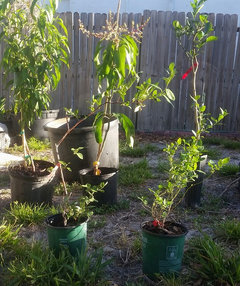
B. Tertzak
5 years agolast modified: 5 years agoHi, I'm hoping to navigate my inexperience and ignorance (w/ a helping of neurosis) here... so apologies in advance for this long-winded post...
I'm not entirely sure if this thread's still active, but I'd really appreciate some advice re the feasibility/method of re-potting/root-pruning a root-bound arborvitae (thuja orientalis) that is currently putting on new growth, is exhibiting some worrisome drying/browning (esp on/around/along the inner branches), and is growing in an environment that makes activity/dormancy (or the lack thereof) quite tricky for me to determine.
We planted/containerized this thuja about a year ago. It seemed to be doing quite well in the conditions/mix/container up to now (and performed quite admirably through the dog days of summer). But it looks/feels like the "soil" it was planted in is, at this point, basically more rootball than "soil".
It has recently begun to brown quite a bit more than I think is normal and might be taking increasingly ominously turns for the increasingly ominous worse.
Given the fact that the average fall/winter temps here are in the lowish 80s, and it is visibly putting on growth I'm not too sure when root-pruning ought to occur and where to even begin w/ conifers.
I've come across some great and incredibly useful stuff on here, so I do hope I'm not bringing up or rephrasing a topic that's already been addressed.
Bare-rooting seems (perhaps predictably for an amateur) daunting, and although biting certain bullets and circumventing geographic/market limitations to put together a faithful gritty mix remains highly desirable, and the task at hand feels pretty much unavoidable given the tree's health, I'd be grateful for some input (to sort of get a handle on what I'm getting into beforehand).
tapla (mid-Michigan, USDA z5b-6a)
Original Author5 years agoHow did you come by this plant in your zone? do you live north or south of the equator? how far?
Root congestion will definitely cause shedding of foliage, starting with that closest to the trunk. As congestion increases, you could end up with only tufts of green growth only near branch apices (the growing tips of the branch). However, spider mites can cause similar damage. Very often, high summer temps can cause root damage that eventually manifests in root rot as the weather cools and moist soil conditions become more prevalent.
As soils break down, some of the finer particles are lost through the pot's drainage holes, but most is lost to gassing off. Soil organisms break down the hydrocarbon chains soil particles are made of, and the carbon reacts with oxygen and forms CO2, which is lost to the atmosphere, which is why the soil/root mass trends more toward a prevalence of roots only as soils age.Al
B. Tertzak
5 years agolast modified: 5 years agoI appreciate your taking the time to respond.
It did come as something of a surprise to us that certain coniferous trees tolerate the climate here (the Tropic of Cancer runs right through us). While the so called Chinese Arborvitae/Platycladus appears to be naturalized in parts of India and Iran, the biodiversity of those countries precludes a "Western Asia" or "Tropical" parallel here.
All/most things considered, the horticultural market in Dubai (assuming there is one flitting about between the reqs of municipal landscaping and the litany of homogenous resorts etc.) is pretty much paint-by-numbers late capitalism 101.
The 2 (to my knowledge) coniferous trees that seem to make it through the summer unscathed -- albeit w/ the benefit of afternoon shade -- are Platycladus and Juniper Sabina "Tam". The latter does not necessarily take too kindly to the humidity, but both seem to be on a sort of par w, say, Cycas R. which'll bleach in full summer sun but otherwise keeps on keeping on (as long as one doesn't drown them via a combination of earnest barbarism and ham-fisted compassion). There's naturally something to be said for planting sites/locations, and the impressive/obscene water-reqs. are well/catalogued.
I've yet to see any spider mites here. I think there was daily watering taking place (especially in July/august) but the mix was draining so freely that I didn't necessarily object to it. That the temps and humidity have been dropping for about a month might have contributed to some potential over/watering taking a toll... That being said, I "discovered" the suspected root-bound-edness when, as I began to reduce the frequency of waterings once the weather changed, I noticed the media was barely holding water, way too much was draining out, and I could hardly get a finger down/in w/o resistance. Perhaps a cumulative chunk of soil did wash/drain away over time... but I don't really know how significant an 8ish month period is re all/most of these facts and the others you've helpfully pointed out.
To be honest I'm hardly a year removed from having zero exp w/ any of this... hell, I'd a tough time just wrapping my head around the basic fact of planting a plant... the nerve-wracking idea that a plant will come out of a smug/snug nursery pot and enter the boundless earth...
So some histrionics aside... this tree was containerized at a point @ in time when I wasntt entirely sure how to approach the removal/planting process rootball-wise etc. It was probably planted in a pot that was too similar to the size of the one it came in, and although the functionalism of moist/well draining was something I was philosophically all/in/on, I think the tree picking up the pace (I.e. Growing) even a skosh made for some pretty rapid (over)crowding.
B. Tertzak
5 years agolast modified: 5 years agoAt the risk of needling a thread I may've turned into a longwinded biopic, I was hoping I could pose a more -- I guess -- fundamental question or two: chiefly re the workability of repotting/root-pruning the aforementioned conifer.
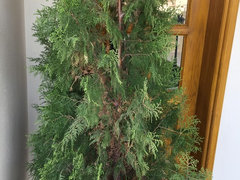
1. Assuming one can go ahead and repot/salvage said tree I was wondering if I should go ahead and adhere to the suggestion that one ought to (when bare-rooting a conifer) mix into the new soil some of the old soil and some chopped up roots from the pruned roots? Supposing the tree'll make it through the procedure, can I saw off 1/3 of the rootmass, remove the majority of the old soil, and prune some of the more unwieldy roots w/o compensating via foliage/branch removal?

2. Considering the fact that I project putting together even a reasonable facsimile of the Gritty Mix (Seramis + appropriately-sized Gravel + Reptibark) here is probably going to clock in @ around $300 for a 26 gallon container... which comes close enough to being unreasonable/absurd... I was curious whether the somewhat bastardized/adulterated version of the 511 I have managed to cobble together might hold up for a year or so? I guess it's a pretty pathetic homage, but I've had some success over the past year w/ my attempts at capturing the spirit (essence? neither?) of that mix given the limited resources. The perlite/peat moss are easy enough to come by, but I'm pretty sure the Pine Bark (roughly between 1/4" to 1/2") is not partially composted (in addition to being, I think, larger than the recommend size). The only form of dolomite I've managed to come across is the incredibly fine white powder(ed) form you get from chem/mineral suppliers (for what it's worth I haven't noticed any undesirable side effects when I've used it in previous mixes).

I hope I'm not looking for possible solutions to a problem that's well passed the point at which something can be done or, for that matter, doubling down on a tree I might've been better off not planting in the first place given the climate/conditions (though the evidence did suggest that it might pan out). I can't necessarily speak to the former aside from saying that I'd really be really grateful for some advice/wisdom. Being able to piece together knowledge and alloy it with what I think approximates practice is pretty much the proverbial's knees. I don't knowif it'll actually mitigate the misplaced chutzpah wafting off/around the the latter decision to plant (maybe I figure I can remedy some of the pitfalls of dilettantism in one go) but I'd really like to take a stab or two at a respectable endgame.
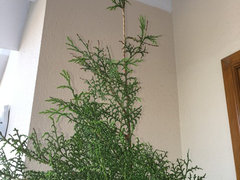
tapla (mid-Michigan, USDA z5b-6a)
Original Author5 years agolast modified: 5 years agoAssuming one can go ahead and repot/salvage said tree I was wondering if I should go ahead and adhere to the suggestion that one ought to (when bare-rooting a conifer) mix into the new soil some of the old soil and some chopped up roots from the pruned roots? Supposing the tree'll make it through the procedure, can I saw off 1/3 of the rootmass, remove the majority of the old soil, and prune some of the more unwieldy roots w/o compensating via foliage/branch removal? You can do that, but pick a time where temps are at their coolest (if there is such a thing there) and humidity is highest. After the repot, briefly protect the plant from direct sun (maybe 3-5 days), and protect from wind until you see new growth.
I was curious whether the somewhat bastardized/adulterated version of the 511 I have managed to cobble together might hold up for a year or so? No reason it shouldn't. Here in the US, most trees & shrubby material are potted in a variety of mixes with healthy fractions of bark. You might benefit from a layered mix if you find it to be less expensive. How close can you come to this:
* Bottom layer -----------------------------------
4 parts sharp gravel 2.5-4mm
2 parts Seramis
1 part bark (It's ok if it's not composted (1/4-1/2 IS rather large, though)
1 part peat
* Middle layer -------------------------------------
2 parts sharp gravel
2 parts Seramis
2 parts bark
1 part peat
* Top Layer -----------------------------------------
3 parts Seramis
2 parts bark
2parts peat
1 part sharp gravel
* You can sub perlite for the sharp gravel. Coarse hort grade is best (3-5mm)
The only form of dolomite I've managed to come across is the incredibly fine white powder(ed) form you get from chem/mineral suppliers. That's fine. The prilled form of dolomite is the same stuff (except perhaps for the reagent purity factor), just mixed with a binder and shot from a prilling tower so it forms little balls while it falls ...... so it is easier to spread with a broadcast spreader.
Hope that helps.
Al
B. Tertzak
5 years agolast modified: 5 years agoThank you sir, that's very generous of you.
I think I can come quite close to the suggested mix. It occurs to me that -- after accounting for the initial reduction of the root mass by a third -- the fact that thoroughly bare-rooting a conifer seems to be inadvisable means I'm likely looking at having to fill only somewhere between 1/3 to 1/2 the volume of a roughly 90 liter (24 gallon) container w new mix. I guess if I'm to leave the remaining root-ball/soil largely intact this smaller volume may serve to mitigate my aversion re ponying up. (Unless I'm off base and have to actually come much closer to removing most/all soil?)
Thanks again. I'm not sure how much of a contribution I'd be making to the thread but I'll be sure to report on how l'arbre fares.Treegeek Z6a (Boston)
5 years agoAl (and others!)
I have to say that your writings and subsequent conversations spurred by them, have 180* changed how I care for my containerized plantings. The two biggest changes thus far have been switching to a fast draining mix (5-1-1), and letting the soil dry between waterings as shown by a wooden tell. This last part is so counterintuitive from what greenhouses, nurseries, and plant centers will tell you to do. If I didn't take the leap last year and witness the power of these two changes, I would still be a doubter, watering when my finger knuckle said the soil was "dry". THANK YOU!
This thread is about trees in containers, which I take to mean any woody plant. I have five plants, across four species, that I consider "woody", and would like your advice on when to root prune, prune and repot.
In terms of planting media, I have plenty of 5-1-1 on hand and like the watering frequency this mix allows. I am not sure that gritty mix is for my lifestyle, in that it needs to be watered more frequently.
Nashia inaguensisThis is in a 5"x5" terracotta pot and is VERY rootbound. I have read these need to be root pruned yearly. When is the best time to do this? If I bareroot, root prune and do some top pruning, can I also put into a bigger pot, or should it stay in the pot it is in? I don't mind it getting larger, I am not looking to keep it the size it is.
Osmanthus fragransI have two.
First is in a 6" unglazed clay pot I did an emergency repot last month due to serious failing health. Should this be left alone for 2019 and just cared for? I plan to topdress with some CSM around May, as this is what Logee's recommends. They say no FP or other synthetic fert.
Second is in a 2.5" plastic pot with roots literally crawling up and out of the top of the container. I want this to get big and have loads and loads of delicious smelling flowers next fall. If I am going to bareroot, put in 5-1-1 and up-pot, should I do any root pruning or leave the roots be? Would you suggest a 4" or 6" pot for this?
Aglaia odorataThis is in a bark based mix, and currently in a 6" plastic pot. again, I want to get it into 5-1-1, bareroot it, and if needed do some root pruning and traditional pruning. Same story as above, it smells wonderful and I want it to put on some size. That being said is a bigger pot necessary?
Operculicarya decaryiThis is in an odd container - it is plastic, 3.5" square at top, but is 5" tall. Currently in a pat based mix, which is rock hard and has roots jumping out. I want this to eventually be thick, with gnarled bark and in a floor standing pot. I want this to be what folks see upon entering my home and have it become a conversation starter.
With all of these, when is the best time to repot for where I live (Boston, MA), and should they all go into unglazed clay pots? Open to, and excited to hear, any and all advice! If photos are needed, I am happy to upload.tapla (mid-Michigan, USDA z5b-6a) thanked Treegeek Z6a (Boston)Just Started(Sydney)
4 years agoI have some questions on root pruning.
I have copied the text and put in my understandings/questions under it.
With a pruning saw, saw off the bottom 1/3 of the root ball.>> Got it.
With a hand-rake (like you use for scratching in the garden soil) and/or a wooden chopstick and/or the aid of water under high pressure from a garden hose, remove all the loose soil. Using a jet of water from the hose and the chopstick, remove the remaining soil - ALL of it. The exception here would be those plants that form dense mats of fine roots (citrus, bougainvillea, rhododendron ...).
>> So in case of citrus I should just remove as much as reasonably possible and leave in the rest?
After the soil is removed, remove up to another 1/3 of the remaining mass of roots with a sharp pruning tool, taking the largest roots, and those roots growing directly under the trunk.
>> So I remove the 1/3 of the roots from the sides since I have already removed the bottom 1/3. Right?>> And also even after removing the bottom 1/3 of roots in first step, I remove still more roots from bottom of the plant? Is it like removing such that a conical shape is left under the plant root?
Stop your pruning cuts just beyond where a smaller root branches toward the outside of the root you are pruning. Be sure to remove any J-hooked roots, encircling/girdling roots or others exhibiting abnormal growth.
>> Did not get this at all.
Also, what do I do with old 511 mix? Can I mix the old one with new mix? I have seen almost no deterioration of 511 mix over a period of 2 years.
Is it a good idea to just root prune and put it back in same size pots? I am space constrained and will like to postpone the pot size upgrade if possible.tapla (mid-Michigan, USDA z5b-6a)
Original Author4 years agoWith a hand-rake (like you use for scratching in the garden soil) and/or a wooden chopstick and/or the aid of water under high pressure from a garden hose, remove all the loose soil. Using a jet of water from the hose and the chopstick, remove the remaining soil - ALL of it. The exception here would be those plants that form dense mats of fine roots (citrus, bougainvillea, rhododendron ...).
>> So in case of citrus I should just remove as much as reasonably possible and leave in the rest? When I prune plants with root systems that form dense mats of fine roots, I usually cut off the bottom 1/3-1/2 of the root mass before I rake out as much of the soil as possible, which s usually around 90%. I then prune the roots directly under the trunk. This produces a root system shaped such that it would fit over an overturned soup bowl. If I think I can work the new soil into the spaces between the root mass, that's what I do, just like I do for plants with a root mass not so dense. If I can't, I'll remove triangular sections of roots (think of a slice of a pie) such that 1/2 of the remaining roots have been removed. The next time I repot, I remove the other half of the roots by removing the 'slices' that remained after the preceding repot.
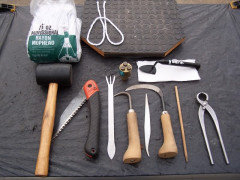
Root rakes like the one to the right of the saw are particularly effective at combing soil out of the roots. They come in 1, 2, and 3 prong models. The tool on the immediate right of that, with 1 prong, is used to disentangling long roots. The homemade white nylon tool to the right of the single hook is very effective at removing single particles of soil wedged between roots - especially those roots very close to the trunk. The dowel rod to the right of the sickle (used to dislodge root masses from the sides of the pot) serves the same purpose. The dowel rod wears out quickly, so I recommend you use an oak dowel if you make your own, or buy a bamboo or stainless steel root pick if you have more than a few trees/woody plants to repot.
After the soil is removed, remove up to another 1/3 of the remaining mass of roots with a sharp pruning tool, taking the largest roots, and those roots growing directly under the trunk.
>> So I remove the 1/3 of the roots from the sides since I have already removed the bottom 1/3. Right? No. After you've removed the bottom 1/3-1/2 of the roots and combed out the soil, you'll start removing large roots that grow upward, more or less straight downward, root that cross, girdle, encircle the pot, or grow back toward the center of the pot. Once that's accomplished, you're likely done with the repotting process other than reestablishing the plant in fresh soil.

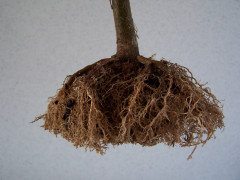
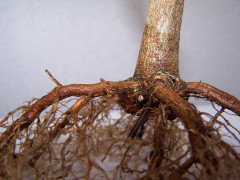
>> And also even after removing the bottom 1/3 of roots in first step, I remove still more roots from bottom of the plant? Is it like removing such that a conical shape is left under the plant root? Yes - see images above.Stop your pruning cuts just beyond where a smaller root branches toward the outside of the root you are pruning. Be sure to remove any J-hooked roots, encircling/girdling roots or others exhibiting abnormal growth.
>> Did not get this at all. When pruning roots, you should pay attention to the direction the root will grow after it's truncated (directional pruning). A root attached to the trunk is a first order root. Second order roots grow out from first order and third order from second order. If you cut through a first order root, the cut should be immediately distal to a second order root. Ideally, the second order root would be growing close to horizontally and radiating outward from the trunk. Cutting roots willy nilly results in the same type of problems associated with shearing the top of a tree/shrub as opposed to actually pruning it.
Also, what do I do with old 511 mix? Can I mix the old one with new mix? I have seen almost no deterioration of 511 mix over a period of 2 years. The rate at which bark/peat soil particles break down would be parabolic on a graph. IOW, after the cellulose in the particles has been consumed by soil life, the older the particle, the faster it breaks down. This has to do with the increase in the ratio of particle size to surface area as the particle ages. You CAN use it if you like. The upside is, it's less expensive. The downside is you often need to screen out the fines (depends on the volume of fines in the fresh soil), and there is increased potential for diseases to to gain a foothold. I would get into the habit of pitching any media that a plant died in. I don't reuse any soils. It's so inexpensive to make fresh, it's not worth it to me. Some bonsai are worth thousands of dollars, others might not be as valuable, but might have 10 or more years of effort invested in their development. It hurts to lose a plant like that to disease.
Is it a good idea to just root prune and put it back in same size pots? I am space constrained and will like to postpone the pot size upgrade if possible. Yes. A plant with a well-maintained root system and a given volume of biomass could easily be maintained in a pot 1/10 the volume (or less) of a plant that has only been potted up from time to time. When I repot a plant for the first time, it almost always goes in a pot somewhere half the volume of the pot it was in when acquired.
Al
pixiek0908
4 years agolast modified: 4 years agoHi all,
I am a total newbie in gardening and hv just accidentally picked up this new hobby.
About 5 months back i bought a small mission fig tree from a local nursery and it was growing well, doubling its height in 3 months with lots of new bigger foliage at the top in its original soil from the nursery. A month ago, the lower leaves started turning yellow and the tree started slowly losing its lower leaves, leaving only the top layer leaves intact. At the same time it stopped growing. The watering/fertilising schedule was as usual, same soil from nursery and tree is in the same spot since it arrived. Nothing's changed. So i searched the net and read that it could be soil getting too compacted. I watered the soil thoroughly until water started draining from the bottom, waited like 15 mins and stuck my finger into the soil. Turns out, top layer was dry as suggested. Repeated and still the same results. So I repotted (removed only abt 50% of old clayey soil) into new 1/1/1 compost/perlite/burnt earth mix, waited a month and still no growth but no further leaves dying either....it became completly dormant.
3 weeks ago I came across Al's posts for the first time and started reading his 10 years worth of info. I found it very useful in understanding soil/water physics....thanks Al for sharing...esp for a new gardener like me.....am still trying to finish reading his posts btw.....So i read about the 511 mix and the gritty mix. So i decided to try it on the fig tree. This time, took tree out, cleaned out all the old soil and repotted into the new 511 mix. Did not see any visible root rot or nematodes or fungus etc. 5 days after repotting, which is today, the remaining top leaves started drooping, is turning yellow and now it looks like the leaves are gonna die. So i cant figure out what's going on and appreciate if i could get some advice.
A few questions for starters....
1) my 511 mix, pine bark 3-5mm, perlite and sphagnum peat moss, is the bark size too big or too small or??
2) do i need to increase the peat portion to 531?
3) what's hapoening with the poor fig tree?
A little info about where i come from, Singapore. This is the country where the first ever Trump-Kim summit took place. We are in the tropical belt just above the equator, with hot and wet weather throughout the year. Humidity is very high mostly and lots of rainfall esp year end (think hawaii minus the hurricanes). I'm staying in a high rise apartment with gentle wind throughout the night. The fig tree is located along the corridor where there is no direct sun but is very bright and partially sheltered. Our tap water comes from reverse-osmosis filtration so not much salt/deposits and is soft. Ph about neutral i believe.
Attached is a pic of the pine bark i used in the 511 mix and a pic of my fig tree.
Rgds,PixK
pixiek0908
4 years agolast modified: 4 years agoFinally managed to upload the pics....
Appreciate advice...thanks!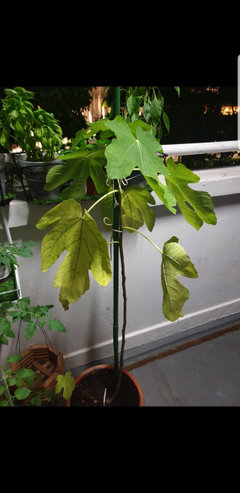
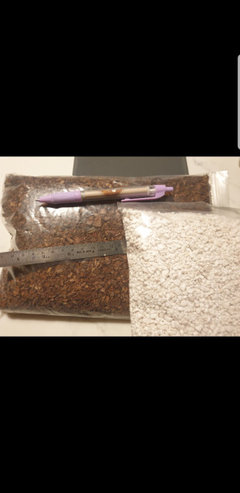
pixiek0908
4 years agolast modified: 4 years agoThanks mblan13.
Because it was just repotted into 511, 5 days ago i thought i should hold the fertilisers for the next 2 weeks. The only fertiliser I used previously was a v thin layer of vermicast mulch (abt quarter inch) once, and that seemed to help the tree grow taller and produce much bigger leaves for the first 3 months before leaves started yellowing and tree stopped growing. Thereafter i tried using this product called seasol powerfeed (NPK 12/1.4/7) for 2 weeks but no effect. Tree remained dormant with only top leaves left (poodle look). I v recently bought a new fertiliser Dyna Gro Foliage Pro 936 after reading the threads. Is this fertiliser alone sufficient on its own?
I am very puzzled and am concerned with what's going on with my fig tree. I suspect its the roots system but i cant figure out what exactly. I'm at my wits end as to what else i could do to help it....sigh.....
Just yesterday i added a thin layer of compost mulch on top of the 511 in the hope that it could retain some moisture....temps here are like 33degC (91degF) daily....the 511 dries out real fast over here.
sguser2099
4 years agoHi pixiek0908 I'm from Singapore too. Have been working on building up gardening and specifically container gardening knowledge. AI and the rest of folks here have been very generous and helpful Roth their sharing.
After the last batch of fruits, I cut it up to be 3 separate plants. Pot them in something similar to 511 mix (more like 311) and 2 grew profusely and stopped their growth around last 3 months. Just 2 weeks ago, they spouted new leaves and 1 is fruiting again. BTW out of 3 pots, 1 didn't make it. Too small, dried up.
What i can share on my experience in our climate is that you have to minimise moisture loss after trimming the roots & repotting into the fresh soil. I recall there is an advice somewhere in the forum to cut the leaves and make them smaller (surface area) so that they can retain the photosynthesis function while waiting for new roots to establish. Mine took roughly 3 weeks to sprout new growth after repotting.
Btw, can you share what's your watering schedule for your repotted fig?Travis in PHX (9b)
3 years agoQuestion for a novice root pruner: Al says most deciduous should be root pruned during quiescence, which was defined as after the tree has been released from dormancy but before new growth starts because soil temps are low. How can you tell when the tree is quiescent?
I live in Phoenix and have a low-chill peach tree. Winters are short here and rarely is the daytime high below 60. I think the border between dormant and activity will be fairly narrow. How can I tell if/when it had been released from dormancy but isn't active yet?tapla (mid-Michigan, USDA z5b-6a) thanked Travis in PHX (9b)tapla (mid-Michigan, USDA z5b-6a)
Original Author3 years agoDecreasing day length (technically, it's increasing night length) pushes a tree toward dormancy in the fall. Chill seals the deal and the tree enters deep dormancy. During this period, the buds of deciduous trees are inactive, but roots can still grow when soil temps are above freezing. An accumulation of chill units is what actually releases the tree from deep dormancy. When the tree has experienced a number of chill units unique to the tree/species (but still variable from tree to tree depending on temp flux) the tree's dormancy requirement can be said to have been satisfied, leaving the tree capable of normal growth, though cold temperatures (below 42* or so) can prohibit above ground parts from growing and keep it in this quiescent (quiet) state until temps warm up to above 45* for several days in a row.
If you're interested in chill units and dormancy, read up on it. You'll learn a number of things contrary to your intuitions. E.g., chill units stop accumulating when temperatures drop below 32*; a period of chilling at 34* yields a different accumulation of chill units than the same period of chilling at 40*, and temperatures fluctuating from between the range of 32-42* to temps above 42* can add to the number of chill units necessary to release a particular tree from dormancy, Finally, some trees require little chilling, being able to accumulate a sufficient number of chill units over the course of a week or so in the 32-42* range, while others require some 2,000 hours at temps between 32-42*
"How can I tell if/when it had been released from dormancy but isn't active yet?" You can't tell by looking unless you see buds swelling. As long as you keep your over-wintering strategy consistent, watch carefully for the first signs of budswell and repot immediately when observed. Make a note of the date; then, next year, repot it about 2 weeks before the onset of budswell. You can use that strategy for all your deciduous plants except maples, which are best repotted (when required) at the first sign of budswell.
AlTravis in PHX (9b)
3 years agoThank you for that quick response Al! I'll be on the lookout for bud swell. This particular peach tree is a genetic dwarf, but since there are no dwarf rootstock for peach, it is grafted onto a standard rootstock. Am I correct that it will need more frequent root pruning (than a tree grown on dwarfing rootstock) because the dwarfing characteristics of the scion wood won't limit the root development?
tapla (mid-Michigan, USDA z5b-6a) thanked Travis in PHX (9b)tapla (mid-Michigan, USDA z5b-6a)
Original Author3 years agoCultural conditions have significantly more influence on how often a tree will need repotting/root pruning than any other consideration - probably even more than pot size.
Al
Travis in PHX (9b)
3 years agoBy cultural conditions do you mean things like the mix, watering and feeding habits, and climate?
tapla (mid-Michigan, USDA z5b-6a) thanked Travis in PHX (9b)tapla (mid-Michigan, USDA z5b-6a)
Original Author3 years agoYes - photo load, fertility, temperature, medium choice, air:water ratio in the medium, and root congestion are the primary factors.
Al
HU-280612785
2 years agoFound this Trees in Container thread and learned so much already to take care of my newly purchased Japanese maple, Coral Bark. It's a 5 ft tree in a 5 gallon container right now. I would like to put it in a decorative container and keep it in a container for many years to come. Since I will have to repot but not necessarily have to pot up as often, what size container should I be looking for? Will it be difficult to remove the tree from a heavy, terra cotta planter to do maintenance on it? I assume that if I don't want the tree to grow 12-15 feet tall, I can control it by repotting but not potting up.
tapla (mid-Michigan, USDA z5b-6a)
Original Author2 years agolast modified: 2 years agoHU-280612785
2 years agoThanks Al for responding. Since my Coral Bark is full of foliage already so do I still pinch at this time? I've attached some photos that I hope these will help you answer my questions that I posted earlier.
Laura

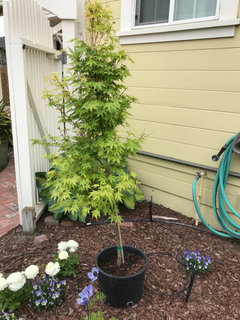

Rebecca Taylor
2 years agoMy husband recently bought a Persian lime tree for me. He could only find a 30gal so that’s what we have. It’s kinda overwhelming. I picked up a cobalt blue glazed ceramic pot that the tree fits into but it is
HUGE! I’ve never root pruned a tree before, but I’m thinking maybe I should start with this one. The tree appears healthy and the nursery pot was full of roots. Not obviously root bound. I have a heavy duty rolling stand for the pot but it’s a dark blue and southern exposure = full hot FL sun all day. Ideas are welcome. I’m mixing up a batch of gritty soil and repotting this weekend. Should I root prune and go with a smaller/lighter colered pot? The puny 15gal lemon next to it is getting repotted into a slightly larger glazed ceramic aqua blue colored pot with gritty mix as well.
tapla (mid-Michigan, USDA z5b-6a)
Original Author2 years agoHi, Rebecca. Can you upload an image of the tree? If you can be patient, it would be best to wait until late March/ early April to repot as the tree revs up for spring growth.
Good thinking in giving consideration to what color the pot should be. A white or cream color, maybe yellow would all work best. You might need to provide shade for at least the pot if you find root/soil temps getting too high.
Al
Rebecca Taylor
2 years agoLemon tree on the right, one big lemon from flowers in spring. Flowers in July had bunch of lemons and the new babies all fell off but one.
The lime is in the pot, crooked, with a store bought mix. I feel like the lemon tree needs attention ASAP- any ideas on variety?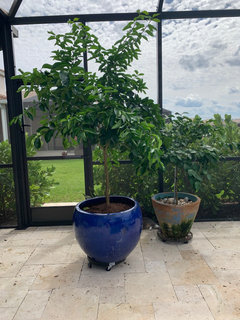
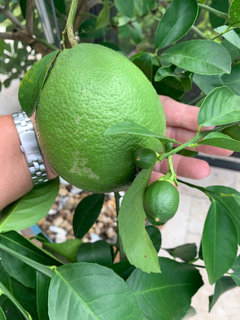

Travis in PHX (9b)
last yearHow does root pruning effect the following harvest in fruit trees? Will it still be able to see fruit after losing so many roots? I have a peach and apricot, as well as citrus. I haven't root pruned yet, but I anticipate needing to this winter/spring.
tapla (mid-Michigan, USDA z5b-6a)
Original Authorlast yearlast modified: last yearPeach and apricot often bear heavily in alternate years. IOW - a heavy crop one year and a light crop the next. If you can detect and identify this habit in your trees, it would be best to root prune while dormant in the spring of the lighter years.
That said, for the peach/apricot trees, root pruning shouldn't have much of an impact on yields or fruit size. In fact, root pruning of in-ground trees is making a comeback as a way to tame wild growth and increase yields in for many types of fruit.
It is a fact that root pruning is an ESSENTIAL part of long term care of trees in containers, unless the tree's care giver is willing to tolerate the decline and loss of vitality that always accompanies root congestion. So, even if it did have an impact on yields, you'd still be pretty much obligated to do the root work.
You probably have seen how growth can come to a virtual standstill due to root congestion. A famous tree biologist pioneer, Dr Alex Shigo, contends, "A tree that isn't growing is dying", and it's true. Trees grow when they create more food/energy (via photosynthesis) than they need to maintain respiring organs and keep their systems orderly, simply because they need a place to store the excess food. Trees stop growing when they make as much as or less food/energy as they use. No organism can sustain itself long term when it uses more energy than it can produce.
So literally, as a containerized tree starts to slow down due to root congestion, it will eventually stop growing and start its terminal decline unless the grower intervenes on the tree's behalf. One might think that trees suffering from root congestion in containers regularly die from the fact they are using more energy than they are using, but that seldom occurs. Plants have a 'pecking order' determined by how strong different organs are in terms of their demand for energy. The stronger the energy sink, the more obligate the plant is to deliver energy to that part. Energy is first allocated to respiratory function, i.e. to maintenance of living tissues, then, to production of fine roots, followed by flower and seed/fruit production, then primary growth (extension of both roots and shoots), then secondary growth (thickening), and finally, the synthesis of defensive chemicals. Notice that defensive chemicals are at the end of the list. Most plants in steep decline, regardless of the reason, usually die from insect herbivory or disease pathogens due to the plant's inability to defend itself.
You can also see by the pecking order (1 - living tissues, 2 - fine roots) that fine roots get the lion's share of energy outlay when the plant's chemical messengers signal an imbalance between top mass and root mass. So the first thing that will occur is, the plant will start regrowing the the roots you pruned off. That puts a temporary hold on top growth until roots catch up. For dormant tree which have been root-pruned, root pruning puts a temporary hold on bud activation until enough new roots have developed to support more top growth.
Let's say you start 2 tree cuttings from the same genetic source in the same size pots. One gets potted up in the spring after you notice the root/soil mass can be lifted from the pot intact, while the other gets a full repot based on the same trigger (root/soil mass can be lifted from the pot intact). After 10 years and all other factors equal, the repotted tree will be many times larger that the tree potted up, it will have far greater vitality, will have produced much more fruit/ nuts/ seed/ ....., and will still be growing in a pot a fraction of the size of the tree that was potted up. Root pruning makes that much difference.
Al
Travis in PHX (9b)
last yearThank you for the explanation. My peach is finishing its second year with me and hasn't fruited yet. But its rootstock is very vigorous. I've up potted it once and it seemed to grow into that new space just a few months later. So I started worrying that I'd have to root prune it every year or maybe every other year, which made me worry about never getting any fruit off it.

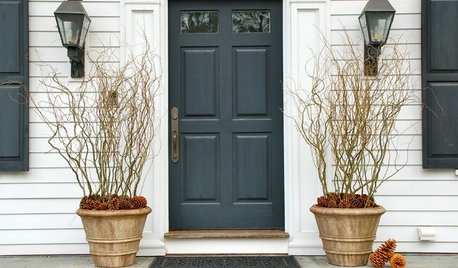


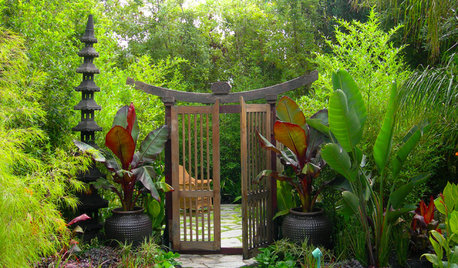
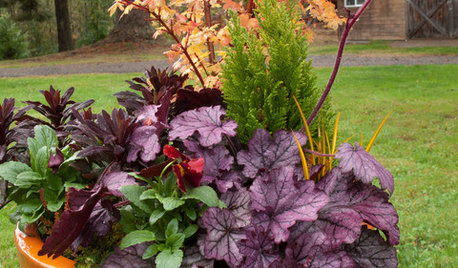
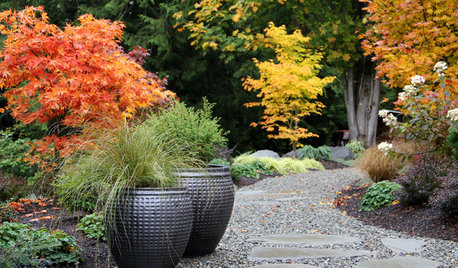
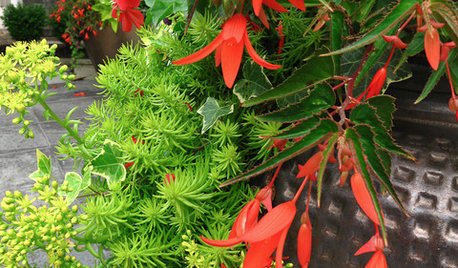











bayareacalifornia